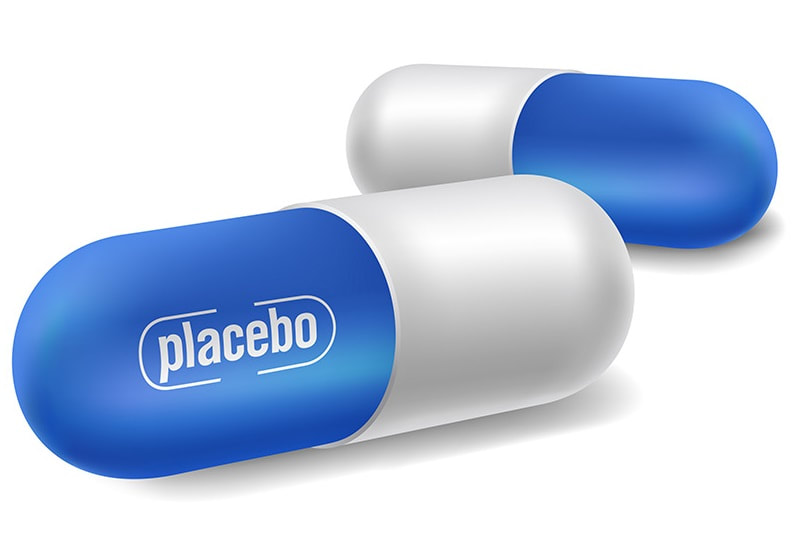“That’s just a placebo effect.”
“It could be placebo.”
“Have you ever heard of the placebo effect?”
The standardized definition of the “Placebo Effect” is as follows… a beneficial effect, produced by a placebo drug or treatment, that cannot be attributed to the properties of the placebo itself, and must therefore be due to the patient’s belief in that treatment.
The scientific establishment has accepted the placebo effect to be a true phenomena observed in thousands of scientific studies across the world. In fact, all drug development is compared versus placebo in order to verify whether the drug provides greater efficacy than the “power of belief”. The mechanisms for which this phenomena transpires has seemingly yet to be fully deciphered. The concept of “belief” having a direct effect on physiology has seemingly perplexed the scientific community. However, since “belief” would appear to coincide with measurable changes in brain activity, EEG analysis would seem to be a logical starting point.
Earlier this year (2016), the journal Frontiers in Computational Neuroscience would publish a study in regards to the EEG changes from placebo in terms of pain evaluation. The results of the study were that placebo treatment exerted significant analgesic (pain killing) effects in 14 out of the 19 participants. There were significant changes in EEG activity from placebo which induced increases and a trend toward increases in the amplitude of alpha oscillations compared to control conditions in the frontal-central area of the brain.It is DMT Quest’s understanding that distinct changes in EEG activity directly correlate with clear fluctuations in hormone and neurotransmitter release.One of the key points as it pertains to the placebo effect is that the mechanisms involved in analgesia would appear to have much overlap with the mechanisms involved in hypnosis-induced analgesia. This is based on the fact that there is no exogenous chemical catalyst that spurs the analgesic reaction. The main differences between the two are that hypnosis generally involves two people (hypnotherapist & patient) rather than one and that hypnosis seems to induce a greater amplification of slower brain waves (theta) compared to placebo (alpha). Hypnosis is theoretically based on bypassing the conscious mind and tapping into the “subconscious” in order to induce an effect. From an EEG perspective, hypnosis slows the predominant brain wave state which appears to coincide with the communication with the “subconscious”. DMT Quest has outlined numerous studies on the dramatic analgesic effects of hypnosis during invasive surgery of various kinds in the second part of the DMT/Gamma Waves series. Perhaps the ability for a person to unknowingly induce “self hypnotic-like states” plays a key role in the effects of placebo in terms of pain?
The corpus callosum (CC) is a wide, flat bundle of neural fibers in the brain connecting the left and right hemispheres. A 2004 study published in the journal Brain outlined the observation that increased corpus callosum size is positively associated with hypnotizability as well as the ability to control pain. It wouldn’t seem overly far-fetched to postulate that measurable differences in CC size might directly correlate with groups of subjects that have significantly greater or lesser response to placebo. This might address one of the mysteries surrounding the placebo effect as to why some people respond more dramatically than others. Nevertheless, it appears that the predominant factor in terms of the strength of the placebo effect is the conviction of belief in the placebo.

5-MEO-DMT is a closely related endogenous analogue to N,N-dimethyltryptamine (DMT). This compound has received much of it’s notoriety from being derived from the Sonoran Desert Toad. 5-MEO-DMT has been cited to have analgesic effects (Brain Research (1985), Physiology and Behavior (1987), Journal of Neural Transmission (1988)) while appearing to be directly influenced by noradrenaline.
A 1991 study in the American Journal of Clinical Hypnosis would showcase a 54% increase in noradrenaline levels for hypnotized patients compared to the control group prior to angioplasty.
(A 2001 overview in Brain Research Reviews details a distinct relationship between noradrenaline and nitric oxide in the placebo effect and relaxation response.)
There has been much chatter recently regarding the powerful effects of ingesting high levels of exogenous 5-MEO-DMT as a catalyst for transcendental experiences. However, much like the discussion surrounding DMT (N,N-dimethyltrytpamine) revolves around the experiences from high level doses, the lower level effects are largely overlooked. There lies the possibility that low levels of 5-MEO-DMT (and DMT) are correlated with the placebo effect and even more so with the analgesic results of hypnosis or meditation.
In 2010, the Journal of Medicine and Life would publish an overview of numerous studies regarding the placebo effect. The paper cites that activation of µ–opioid receptors is considered to be the main mediator of the analgesia induced by placebo effect. However, within this review a 1999 study in The Journal of Neuroscience would showcase the potentiality for alternative pathways for placebo based pain suppression outside of the opioid system.
A 2008 paper in the journal Current Neuropharmacology would provide an overview regarding the therapeutic potential of Sigma-1 receptor ligands. It is cited that Sigma-1 receptor ligands have the potential to induce analgesic effects in the absence of opioid compounds. A 2003 study in the journal Pharmacology observes profound, non-opioid based analgesia produced by a 5-HT1A receptor agonist. This is intriguing based on the high affinity that 5-MEO-DMT appears to have for the 5-HT1A receptor as well as the Sigma-1 receptor.
A 2016 study in The Journal of Neuroscience outlines the fact that meditation induced analgesia does not involve endogenous opioids. The study would compare reduction in pain intensity from meditation after having administered opioid antagonist naloxene or saline placebo. This furthers the speculation that 5-MEO-DMT potentially plays a key role in analgesia as it is not an opioid. It’s quite obvious that the complexity of the brain-body connection is immense and something that “science” is just beginning to scratch the surface of.
In 2003, the Journal of the National Cancer Institute would publish a review of 37 placebo controlled trials in regards to cancer drug development. The article would cover the response rate of placebo in terms of pain, appetite, weight gain, performance status, quality of life, and tumor response (shrinkage). There was a 2.7% (10 out of 375 patients) tumor response which included all the studies including 3 spontaneous remissions in the 1998 kidney cancer study.
While a 2.7% tumor response might be considered insignificant, it would be extremely interesting to study these 10 patients to compare their physiology, biochemical make-up, and EEG activity compared to the rest of the patients. Obviously it would be an impossibility for that particular group but I think you can comprehend my inference.

The concept of placebo is based on biological mechanisms that take place based on a thought or belief. If we are able to reverse engineer how the effect takes place, we are then capable of not only replication but also increasing the response. It might be possible to increase the tumor response from 2.7% to 27% and eventually much higher. Hypnosis or hypnotic-like states including mediation, Wim Hof Method, and various mindful exercises appear to have the potentiality to enhance the placebo effect based on much of what we have covered at DMT Quest thus far.
It would appear important to acknowledge the effects of 5-MEO-DMT as well as DMT that do not encompass purely transcendental states. As it’s been stated incessantly on DMT Quest, there are levels to everything and low levels of both of these compounds might play a greater role in our everyday lives than we are currently aware of. Obviously both of these molecules are integrated within cascade effects of the body coinciding with distinct fluctuations of dozens of hormones and neurotransmitters. While it’s clear that the placebo effect is perceived as being synchronous in addressing pain in the body, it’s even more interesting to fathom complete reversal of disease via increased amplification of the mechanisms.
(It’s interesting to note that according to multiple studies, there seems to be distinct alterations in autonomic nervous system activity/control from meditation, hyperventilation, hypnosis, “Wim Hof Method”, and REM sleep. As we’ve touched upon consistently at DMT Quest, we believe that all these altered states of consciousness lead to increased levels of endogenous DMT(s). Unsurprisingly, a 2011 write-up in Philosophical Transactions of the Royal Society of London B: Biological Sciences cites multiple experimental studies alluding to an intimate relationship between the placebo effect and changes in autonomic nervous system activity.)
It would seem that an optimization of not only the understanding of the placebo effect but how to enhance it would be a priority for humanity. It’s not overly complicated to fathom that a change in mindset alters brain activity measurable via EEG which correlates with distinct fluctuations in biochemical release coinciding with neural pathway formation that addresses the condition.
If only 5% of the annual $60 billion spent on pharma/biotech research to develop inferior drugs (yeah I said it) could be allocated to deciphering the power of the mind, the world would literally change in short order. At some point a mildly educated public will be literally sick (pun and no pun intended) of dealing with the high costs of drugs and their low effectiveness based on the severely antiquated strategy of tinkering with receptors in order to mask disease symptomatology while negating the side effects of long-term organ damage and root cause of the illness. It’s important to remain cognizant that “science” is not an organization run by a person or group of people. Science is a field and methodology of studying/organizing something. There are entities within the field of science that design studies to “further knowledge” and develop products perceived as “beneficial” but the percentage of those studies intertwined with the the goal of monetary gains dominates the field. The amount of capital allocation within science is vastly imbalanced in terms of funds utilized for studies benefiting humanity and studies benefiting an organization with shareholders.
They are obviously not one in the same.
There’s nothing inherently “wrong” about shareholders and capitalism I suppose but there does seem to be a conflict of interest when it comes to human healthcare. The cost to develop one prescription drug that receives FDA approval has been cited to hover in the $2.5 billion range. The fact that no entity or even group of entities within science have ever allocated a total of $2.5 billion to deciphering the placebo effect and other inherent innate abilities within humans is rather telling.
It will be no surprise in the near future when humans begin to realize that much of our physical, mental, and emotional ailments can be much more effectively addressed by adjusting one’s diet, sleep habits, mindfulness, digestive system integrity, breathing patterns, endocrine system optimization, and exposure to nature’s elements. It’s inevitable at this point… the only question is whether you will be behind the curve or ahead of the curve.
End mini-rant.
(PS. I’m not adverse to “big pharma”… I’m adverse to inferior products of any kind, anywhere. They are wasteful and have no legitimate reason to exist.)
DMT Quest is a non-profit 501(c)3 dedicated to raising awareness and funds for endogenous DMT Research. This specific field of psychedelic research has been underfunded for many decades now. It’s time to take our understanding of human physiology, abilities, and perception to the next level. E-mail me at jchavez@dmtquest.org with any comments or questions. You can also follow us at Facebook, Instagram, or Twitter.
(Here is a 16 minute audio track that might provide you with a glimpse of what it feels like to produce lower levels of 5-MEO-DMT. Just try to stay focused on the directions throughout.)
